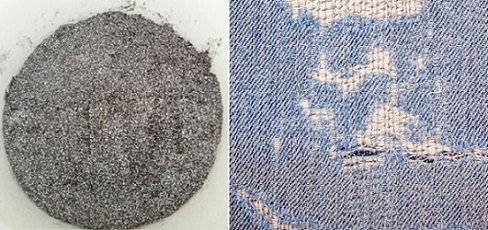Definition of Water Vapour Transmission (WVT) The mass of water vapour that passes, vertically, through…
Abrasion Resistance of Textile Fabrics (ASTM D3884) and Organic Coatings (ASTM D4060) by the Taber Abraser
Table of Contents
★Application scope of wear resistance test standard: ASTM D4060 and ASTM D3884
ASTM D4060: Standard test method for abrasion resistance of organic coating by the Taber abraser.
Many mechanical parts require impact resistance, corrosion resistance and wear resistance, but most of the substrate cannot meet these requirements itself. In order to reduce the abrasion of the equipment parts, it is necessary to apply a layer of wear-resistant coating material on the surface of the parts for improving the wear resistance of the equipment parts.

ASTM D3884: Standard Guide for abrasion resistance of textile fabrics (rotary platform, double-head method).
The abrasion of textile fabrics refers to the gradual damage formed by repeated friction of the fabric with another object. In the process of using the fabric, because of the different occasions of use, it will be affected by various external factors, and gradually reduce the durability until the final damage, the practice has proved that abrasion is one of the main causes of damage.
★Taber abraser / Taber abrasion tester
Under certain pressure and wear action, mount the specimen (rigid panel or fabric coated with organic coating) on an friction device with adjustable rotating platform. Fix the specimen on a platform, and the face to be tested is opposite to the grinding wheels. One wheel rubs the outer surface of the specimen outward toward the circumference and the other wheel rubs the inner surface inward toward the center of the circle.
Taber abraser / Taber abrasion tester
Sample holder, consisting of rubber pads, splints, and nuts. Fix the specimen on the rotary platform and clamp the specimen with a clamping ring. A pair of rotating arms, abrasive wheels and weights can be mounted on the rotating arm. The load of the abrasive wheel can be adjusted by adding weights of different weights (250g, 500g, 1000g) after consultation by the parties concerned.
Abrasive wheel: It is recommended to use Taber wear-resistant rubber wheels, CS-10 or CS-17, and other abrasive wheels can be used after the agreement of the supply and demand parties. Because of the slow hardening of the adhesive material, grinding wheels that exceed the product marking date or purchase period of more than one year should not be used. In ASTM D4060, the thickness of the grinding wheel is 12.7±0.3mm, the outer diameter of the unused grinding wheel is 51.9±0.5mm, and the diameter of the grinding wheel shall not be less than 44.4mm. In ASTM D3884, the grinding wheel diameter is about 50mm and the thickness is 13mm.
★The test evaluation process mainly involves three steps: sample preparation, sample abrasion, assessment report.
1 Sample preparation of ASTM D4060 and ASTM D3884:
| Sample preparation of ASTM D4060 | Sample preparation of ASTM D3884 |
| The specimen is a round or square plate with a hole in the center of the panel with a diameter of 6.5mm. The typical size is a 100mm disc diameter or a square with a side length of 100mm, and the thickness of the specimen is not greater than 6.3mm. | Cut ten square samples with side length about 15cm, five pieces for abrasion test with a hole (ø6mm) in the center, five pieces reserved for control. For specimens with a width of 125mm or more, sampling at a distance of 25mm from the cloth edge. For specimens with a width less than 125mm, sampling with the entire width. |
| Unless otherwise agreed by the parties concerned, preconditioning the coating plates at least 24 hours at (23±2)℃ and 50%±5% relative humidity. Test the specimen in the same environment or immediately. | Precondition the sample to achieve moisture equilibrium in the standard atmosphere. Test the prepared specimens in the standard atmosphere at a temperature of (21±1)℃ and relative humidity of 65%±2%. |
2 Specimen abrasion
The wear of the specimen is mainly reflected in the following ways in ASTM D4060.
2.1 Wear Index: Compute the wear index, I, a loss of 1000 times the weight of a cycle of rotation.
I = (A – B) 1000 / C
where:
A = weight of the test specimen before abrasion, mg
B = weight of the test specimen after abrasion, mg
C = number of cycles of abrasion recorded.
2.2 Weight Loss: Compute weight loss, L, the weight loss of the required rotation cycle.
L = A – B
where:
A = weight of the test specimen before abrasion, mg
B = weight of the test specimen after abrasion, mg
2.3 Wear Cycles Per Mil: Compute the wear cycles per mil, W.
W = D / T
Where:
D = number of cycles of abrasion required to wear coating through to the substrate.
T = thickness of coating, mils
(1mil = 0.001inch = 0.0025cm)
In ASTM D3884, there is no specific method of specimen wear, and only a commonly used test procedure is provided by the enterprise. Evaluate the results in accordance with the standard requirements when the specimen has finished the wear test at the set number of cycles or reached the end-point of other requirements.
3 Assessment report
| Assessment report of ASTM D4060 | Assessment report of ASTM D3884 |
| Temp and RH during conditioning and testing. | Temp and RH during conditioning and testing. |
| The thickness of the coating when wear cycles are specified. | Describe the product sampled and the method of sampling used for the lab sampling. |
| Kind of abrasive wheels used. | Type of wheel used. |
| Load applied to the abrasive wheels. | Load adjustment or counter weight, if used. |
| Number of wear cycles recorded for each test specimen. | Vacuum suction level, and height of the vacuum pick-up nozzle. |
| Wear index, weight loss, or wear cycles per mil for each test specimen. | Residual breaking force, percentage loss in breaking load, average cycles to failure on teh other end-point. |
| Mean and range of the abrasion resistance values of the replicate coated panels. | If any other means of evaluating the effect of abrasion are used, describe evaluation criteria used to obtain failure or other end-point. |
In ASTM D3884, the assessment should be based on the following:
Residual breaking force: If residual breaking force is required, calculate the individual breaking force of the individual abraded specimens and the unabraded specimens to the nearest 0.5kg significant digits. Use the test method ASTM D5034 and ASTM D5035 by the textile tensile testing machine.
Average breaking strength: If average breaking strength is required, calculate the average breaking strength of the abraded specimens and the unabraded specimens separately to the nearest 0.5kg for the laboratory sampling unit for the lot.
Percent loss in breaking strength: If percent breaking strength is required, calculate it to the nearest 1% as the abrasion resistance separately for each the lengthwise and widthwise directions using the following equation, for the laboratory sampling unit and for the lot.
AR = 100 (A – B) / A
Where:
AR = abrasion resistance, %
A = average breaking force of the unabraded specimens, g
B = average breaking force of the abraded specimen, g
Cycles required to a specified end-point: When the results of the wear resistance test are to be stated in a material a specification or contract provisions, there is a requirement to pass/fail the standard. This standard may include breaking strength loss, yarn breakage, coating loss, gloss loss, pilling condition, color loss, and other appearance changes. In these items, friction specimens are usually compared to known test criteria.
The abrasion resistance of the fabric is one of the common physical test items, and there are many cases of wear, abrasion, and tear. In order to simulate the actual wear of the fabric, we need to pass different forms of wear/abrasion/pilling resistance testing, comprehensively analyze the abrasion resistance of the fabric.





This Post Has 0 Comments